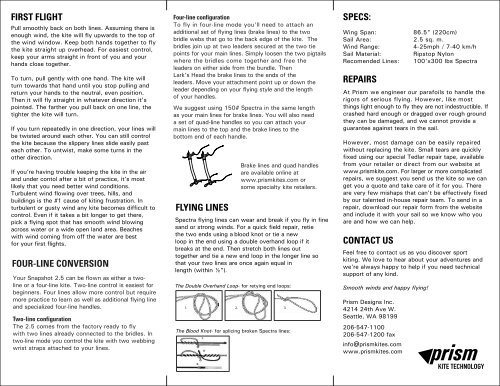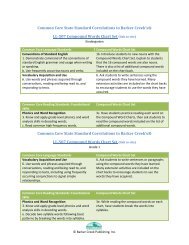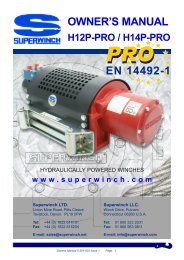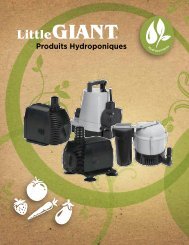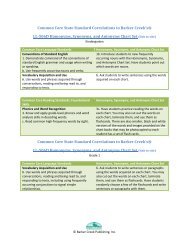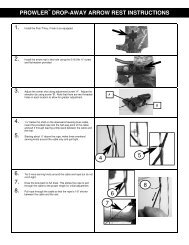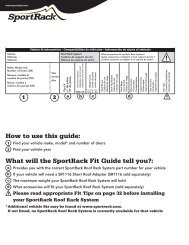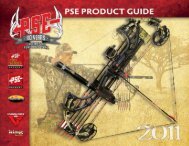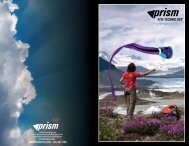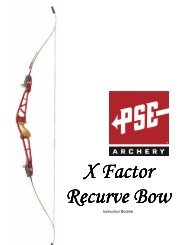Create successful ePaper yourself
Turn your PDF publications into a flip-book with our unique Google optimized e-Paper software.
FIRST FLIGHT<br />
Pull smoothly back on both lines. Assuming there is<br />
enough wind, the kite will fly upwards to the top of<br />
the wind window. Keep both hands together to fly<br />
the kite straight up overhead. For easiest control,<br />
keep your arms straight in <strong>front</strong> of you and your<br />
hands close together.<br />
To turn, pull gently with one hand. The kite will<br />
turn towards that hand until you stop pulling and<br />
return your hands to the neutral, even position.<br />
Then it will fly straight in whatever direction it’s<br />
pointed. The farther you pull back on one line, the<br />
tighter the kite will turn.<br />
If you turn repeatedly in one direction, your lines will<br />
be twisted around each other. You can still control<br />
the kite because the slippery lines slide easily past<br />
each other. To untwist, make some turns in the<br />
other direction.<br />
If you’re having trouble keeping the kite in the air<br />
and under contol after a bit of practice, it’s most<br />
likely that you need better wind conditions.<br />
Turbulent wind flowing over trees, hills, and<br />
buildings is the #1 cause of kiting frustration. In<br />
turbulent or gusty wind any kite becomes difficult to<br />
control. Even if it takes a bit longer to get there,<br />
pick a flying spot that has smooth wind blowing<br />
across water or a wide open land area. Beaches<br />
with wind coming from off the water are best<br />
for your first flights.<br />
FOUR-LINE CONVERSION<br />
Your <strong>Snapshot</strong> <strong>2.5</strong> can be flown as either a twoline<br />
or a four-line kite. Two-line control is easiest for<br />
beginners. Four lines allow more control but require<br />
more practice to learn as well as additional flying line<br />
and specialized four-line handles.<br />
Two-line configuration<br />
The <strong>2.5</strong> comes from the factory ready to fly<br />
with two lines already connected to the bridles. In<br />
two-line mode you control the kite with two webbing<br />
wrist straps attached to your lines.<br />
Four-line configuration<br />
To fly in four-line mode you’ll need to attach an<br />
additional set of flying lines (brake lines) to the two<br />
bridle webs that go to the back edge of the kite. The<br />
bridles join up at two leaders secured at the two tie<br />
points for your main lines. Simply loosen the two pigtails<br />
where the bridles come together and free the<br />
leaders on either side from the bundle. Then<br />
Lark’s Head the brake lines to the ends of the<br />
leaders. Move your attachment point up or down the<br />
leader depending on your flying style and the length<br />
of your handles.<br />
We suggest using 150# Spectra in the same length<br />
as your main lines for brake lines. You will also need<br />
a set of quad-line handles so you can attach your<br />
main lines to the top and the brake lines to the<br />
bottom end of each handle.<br />
FLYING LINES<br />
Spectra flying lines can wear and break if you fly in fine<br />
sand or strong winds. For a quick field repair, retie<br />
the two ends using a blood knot or tie a new<br />
loop in the end using a double overhand loop if it<br />
breaks at the end. Then stretch both lines out<br />
together and tie a new end loop in the longer line so<br />
that your two lines are once again equal in<br />
length (within ½").<br />
The Double Overhand Loop- for retying end loops:<br />
1.<br />
The Blood Knot- for splicing broken Spectra lines:<br />
2.<br />
Brake lines and quad handles<br />
are available online at<br />
www.prismkites.com or<br />
some specialty kite retailers.<br />
3.<br />
SPECS:<br />
Wing Span:<br />
86.5” (220cm)<br />
Sail Area: <strong>2.5</strong> sq. m.<br />
Wind Range:<br />
4-25mph / 7-40 km/h<br />
Sail Material:<br />
Ripstop Nylon<br />
Recomended Lines: 100'x300 lbs Spectra<br />
REPAIRS<br />
At Prism we engineer our parafoils to handle the<br />
rigors of serious flying. However, like most<br />
things light enough to fly they are not indestructible. If<br />
crashed hard enough or dragged over rough ground<br />
they can be damaged, and we cannot provide a<br />
guarantee against tears in the sail.<br />
However, most damage can be easily repaired<br />
without replacing the kite. Small tears are quickly<br />
fixed using our special Tedlar repair tape, available<br />
from your retailer or direct from our website at<br />
www.prismkite.com. For larger or more complicated<br />
repairs, we suggest you send us the kite so we can<br />
get you a quote and take care of it for you. There<br />
are very few mishaps that can't be effectively fixed<br />
by our talented in-house repair team. To send in a<br />
repair, download our repair form from the website<br />
and include it with your sail so we know who you<br />
are and how we can help.<br />
CONTACT US<br />
Feel free to contact us as you discover sport<br />
kiting. We love to hear about your adventures and<br />
we're always happy to help if you need technical<br />
support of any kind.<br />
Smooth winds and happy flying!<br />
Prism Designs Inc.<br />
4214 24th Ave W.<br />
Seattle, WA 98199<br />
206-547-1100<br />
206-547-1200 fax<br />
info@prismkites.com<br />
www.prismkites.com


